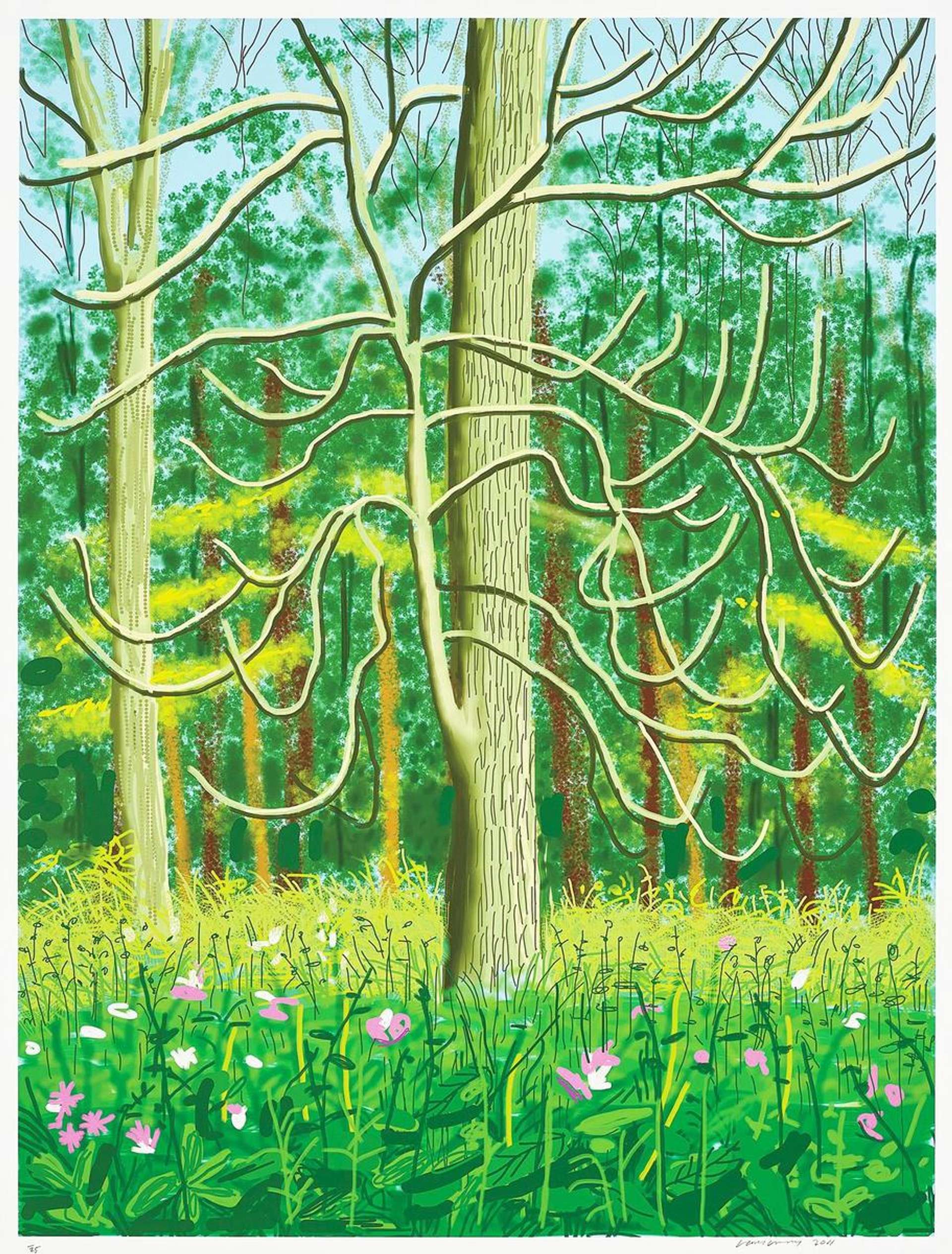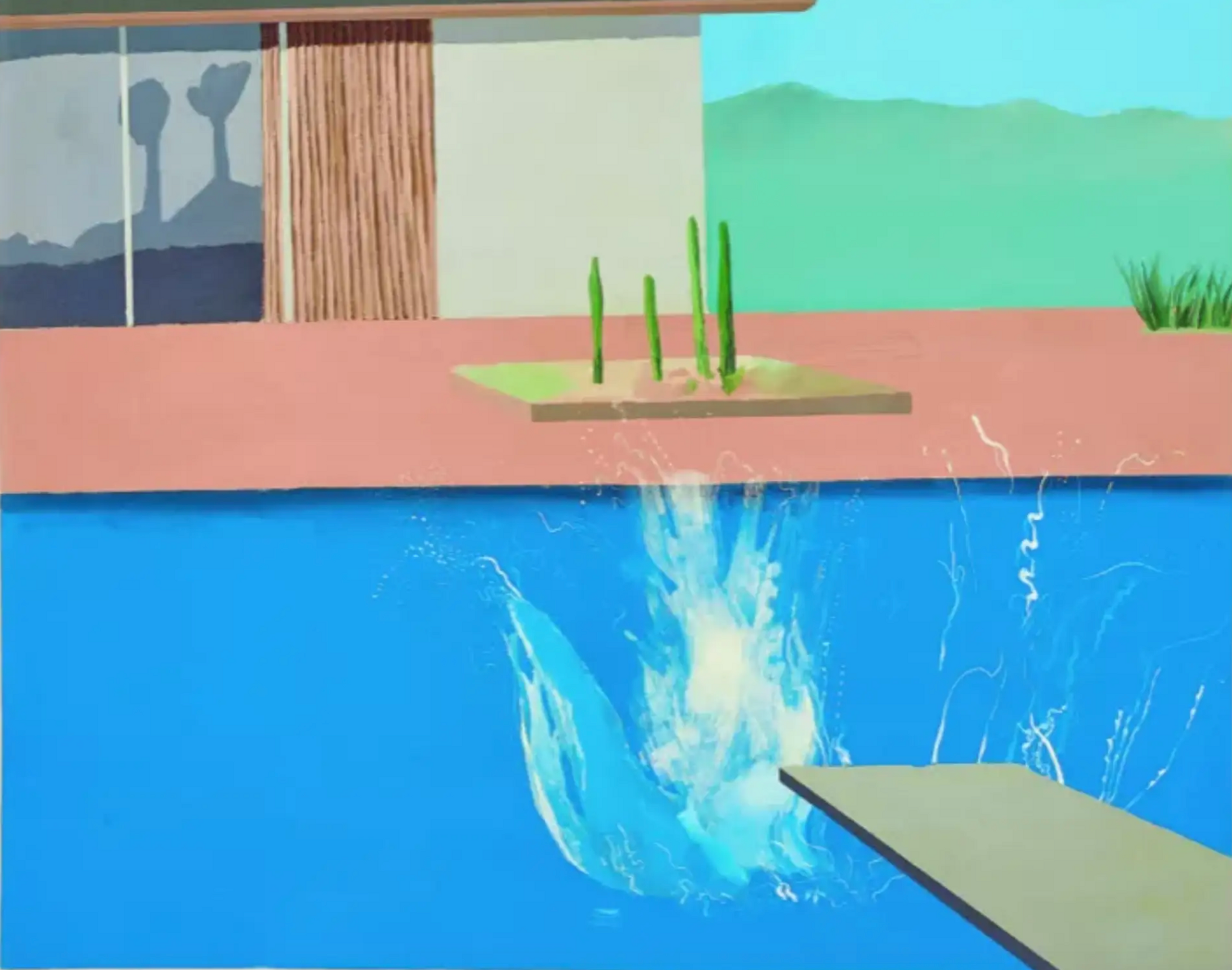 Image © Christie's / Portrait of an Artist (Pool with Two Figures) ⓒ David Hockney, 1972
Image © Christie's / Portrait of an Artist (Pool with Two Figures) ⓒ David Hockney, 1972
David Hockney
651 works
David Hockney has become an icon of British art over his illustrious career, combining a range of different styles to produce his bright, colourful paintings and sculptures. The Yorkshire born artist became an emblem of British Pop Art in the 1960s before moving to California in 1964, where the sun-drenched, sexually liberated atmosphere that he encountered transformed both his style and subject matter.
In this article, we take a look at five of Hockney’s most famous paintings to trace the development of the artist’s style, subject matter and process, from his beginnings in the bohemian London of the 1960s to his colourful depictions of California to his more sombre portraits of his parents just before their death.
 Image © Sotheby's / The Splash ⓒ David Hockney, 1967
Image © Sotheby's / The Splash ⓒ David Hockney, 1967The Splash (1967)
After enjoying newfound success in London, where he had just sold his piece A Rake’s Progress (1963) – a contemporary reworking of Hogarth’s series of the same name – for a large sum, Hockney moved his studio from dreary post-war London to glamorous California. There, he encountered a sexually liberated atmosphere; whilst homosexuality was still illegal in the UK, gay culture was booming in Los Angeles, allowing Hockney a greater degree of both artistic and personal freedom. The swimming pool became a landmark of Hockney’s paintings, representing the exuberance, wealth and sexual intrigue of American culture.
In The Splash, the painting’s bright tones bring the Californian landscape to life, and the realistic style of the splash itself gives the painting a sense of immediacy, and yet also a sense that the viewer has just missed the action.
In 2006, The Splash sold for £2.9 million to an anonymous buyer. The work was subsequently resold in 2020 at a Sotheby’s auction in London to an anonymous buyer for the princely sum of £23.1 million. As demand for high-value art has surged, so has Hockney's market value, exemplified in 2018 when his Portrait of an Artist (Pool with Two Figures) sold for over £70 million, setting an auction record at the time for a living artist.
Mr and Mrs Clark and Percy (1971)
Although Hockney was living in California at the time of this painting’s creation, he was very much still embedded in the bohemian London scene of the 1960s and 1970s, as the portrait’s subject indicates. The painting depicts the fashion designer Ossie Clark and the textile designer Celia Birtwell in their flat in Notting Hill Gate shortly after their wedding, where Hockney had been the best man.
Like many of Hockney’s depictions of London, the painting’s colours are rather muted and its figures are painted contre jour (against the light), with the couple’s glamorous but dark clothes and interior decor clashing against the brightness of the cat’s fur. The half-closed shutters, which open out slightly to reveal a sunny balcony and tree below, give a glimpse of a world outside the darkened room. The painting is often thought to recall the famous Arnolfini Marriage (1434) by the Flemish renaissance painter Jan Van Eyck, in which a small dog rests at the couple’s feet. Hockney’s version resets this classic portrayal of love and fidelity within the glamorous 1970s London art scene, whose dark palette casts a somewhat melancholic air over the piece.
 Image © Christie's / Portrait of an Artist (Pool with Two Figurines) ⓒ David Hockney, 1972
Image © Christie's / Portrait of an Artist (Pool with Two Figurines) ⓒ David Hockney, 1972Portrait of an Artist (Pool with Two Figures) (1972)
Hockney continued to use the swimming pool as a motif of luxury and sexual freedom in this famous painting, which depicts an underwater figure swimming towards a man who stands at the edge of the pool looking over him.
Like The Splash, Hockney’s bright colour palette enhances the greens of the California landscape in the background against the garish pink of the man’s suit. The dynamic between the two figures is intriguing; the swimming figure seems unaware of the sinister presence of the standing man who looms over him and whose expression and intent are difficult to decipher. Is he looking at the swimming figure with love or anger? Is he about to jump into the pool, or waiting for him to get out?
The painting is based on Hockney’s 1972 photograph John St Clair Swimming, and its creation formed part of Jack Hazan’s documentary A Bigger Splash, which was filmed over three years in Hockney’s studio. The painting sold at Christie’s in 2018 for US$90 million (£70 million), becoming the most expensive artwork by a living artist ever sold at auction, at least until Jeff Koons’s Rabbit broke the record in 2019.
 Image © Tate / My Parents © David Hockney 1977
Image © Tate / My Parents © David Hockney 1977My Parents (1977)
Whilst this painting retains the bright colour palette of Hockney’s swimming pool paintings, its subject matter is far more sombre. Hockney was living in Paris at the time of the painting, which he completed on a visit back to Bradford. The depiction of his parents seems slightly strained; whilst his mother stares directly into the “lens” of the painting, his father (who died just a year after the painting was completed) is bent over a book, his face partially obscured by the position.
Colour also plays an important part in their characterisation, with the bright blue of his mother’s dress, the furniture and flowers contrasting with the comparative drabness of his father’s clothes. The distance between the two figures and their different gazes speaks of isolation and restraint, perhaps reflecting Hockney’s view of his home in light of liberated Paris and California.
Self Portrait with Red Braces (2003)
Painted when the artist was in his early seventies, this self-portrait reveals a distinct self-awareness and direct engagement with the viewer. Whilst Hockney at first appears to be looking directly into the eyes of the viewer, after close attention we feel that he is perhaps looking into his own eyes as he paints himself, perhaps using a mirror. And yet we can see that, on the piece of paper which he paints on, he has only made one brush stroke, whereas we are obviously seeing a complete portrait.
The bright primary colours and rough brush strokes contrast with the precision of Hockney’s earlier work, perhaps giving a sense of the decline or change of age. The portrait simultaneously gives a sense of Hockney’s increasing awareness of self and his turn towards a more direct, playful style that moves away from the precision of his earlier work.
Self Portrait with Red Braces is currently on display at the National Portrait Gallery in London, amongst other works including David Hockney ('Self Portrait 30th Sept.') and 'Self-Portrait with Charlie' (David Hockney; Charles Dare Scheips)




